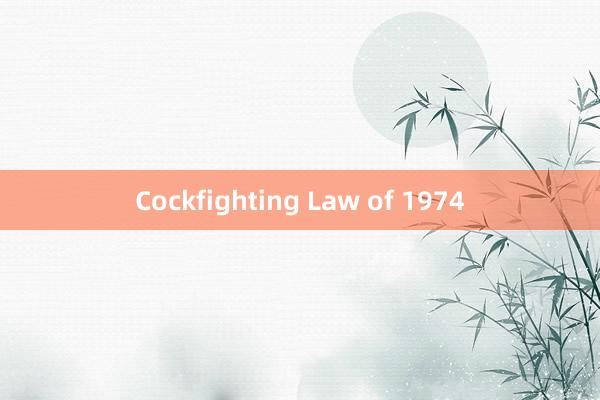
Cockfighting Law of 1974: A Landmark in Animal Welfare Legislation
The Cockfighting Law of 1974 marks a significant turning point in the United States' effort to regulate animal cruelty and protect the rights of animals, particularly those used in the blood sport of cockfighting. Enacted as part of a broader movement toward animal welfare, this law set a legal precedent by addressing one of the oldest and most controversial forms of animal fighting.
Cockfighting is a brutal sport in which roosters, specially bred and trained for aggression, are placed in an arena to fight each other, often to the death. These birds are equipped with sharp spurs or blades to enhance the lethality of the fight. The sport has deep historical roots, dating back centuries in various cultures around the world. However, despite its long-standing history, cockfighting has been widely condemned for its cruelty and the suffering it inflicts on the animals involved.
In a typical cockfight, two birds are forced to battle while spectators place bets on the outcome. The fights are violent and often result in severe injuries or death for one or both animals. Prior to the Cockfighting Law of 1974, this blood sport was either unregulated or tolerated in several states across the U.S., even though it was a violation of basic principles of animal welfare.
By the early 1970s, growing public awareness and concern for animal rights led to increased scrutiny of activities like cockfighting. Animal welfare organizations and activists campaigned for legal reforms to put an end to these violent practices. The Cockfighting Law of 1974 was introduced as part of a series of federal legislative measures designed to strengthen animal cruelty laws and impose stricter penalties on those who engaged in or promoted cockfighting.
The passage of this law followed a broader societal shift toward recognizing the moral and ethical treatment of animals. As attitudes toward animals evolved, there was an increasing consensus that cockfighting,Dàn 36 Con T3 N8_ Chìa Khóa Tối Ưu Trong Việc Phát Triển Phần Mềm Tiếng Việt despite its traditional roots, Cuộc Bách Thí Hôm Nay – Khám Phá Cuộc Sống Từ Những Điều Nhỏ Nhặt was no longer acceptable in a modern society.
The Cockfighting Law of 1974 was one of the first federal laws to specifically address animal fighting, Vip Casino Games - Trải Nghiệm Sòng Bạc Hạng Sang making it illegal to sponsor, participate in, or attend cockfights in any U.S. state where such activities were outlawed. While some states had already taken steps to ban cockfighting, this law provided a uniform standard across the country, creating a federal framework to crack down on this form of animal cruelty.
One of the key aspects of the law was its focus on interstate commerce. Under the 1974 statute, it became illegal to transport animals across state lines for the purpose of cockfighting, even if the activity was legal in the state where the fight was to take place. This provision made it significantly harder for cockfighting organizers to operate across jurisdictions and helped to curb the practice by limiting the movement of birds used in these fights.
go88 comIn addition to prohibiting cockfighting itself, the law imposed penalties on individuals involved in the sale, trade, or breeding of animals for the purpose of fighting. These penalties included fines and possible imprisonment, depending on the severity of the offense.
The Cockfighting Law of 1974 was a landmark achievement in the fight against animal cruelty in the United States. It established a clear legal framework for combatting cockfighting and set the stage for further legislation in the years that followed. Over time, this law helped to raise awareness about the brutal nature of cockfighting and solidified the federal government’s stance on animal welfare.
However, despite the legal restrictions imposed by the 1974 law, cockfighting continued in some areas, particularly in rural and underground communities where the sport had deep cultural ties. In response to ongoing violations, Congress passed additional laws in the subsequent decades, further strengthening penalties and closing loopholes that allowed cockfighting to persist. Notably, the Animal Fighting Prohibition Enforcement Act of 2007 and the Animal Fighting Spectator Prohibition Act of 2014 built on the 1974 law by increasing penalties for attending cockfights and making it a federal crime to bring minors to these events.
The success of the Cockfighting Law of 1974 was not solely due to the legislative effort but also to the persistent work of animal rights groups and law enforcement agencies. Organizations like the Humane Society of the United States (HSUS) played a pivotal role in lobbying for stronger laws, conducting undercover investigations, and raising public awareness about the horrors of cockfighting.
Enforcement of the law, however, has remained a challenge in some regions, as cockfighting continues to thrive in certain communities, often in clandestine settings. This has necessitated ongoing vigilance from both law enforcement agencies and animal welfare organizations to ensure that the legal protections provided by the 1974 law are upheld.
The Cockfighting Law of 1974 represents a critical moment in the history of animal welfare in the United States. It was one of the first federal laws to address the specific issue of animal fighting and set the stage for further legislation aimed at protecting animals from cruelty and exploitation. While challenges remain in fully eradicating cockfighting, the 1974 law laid the groundwork for future progress and reflected a growing societal commitment to treating animals with dignity and respect.
jili ko comwww.lawrencevale.com